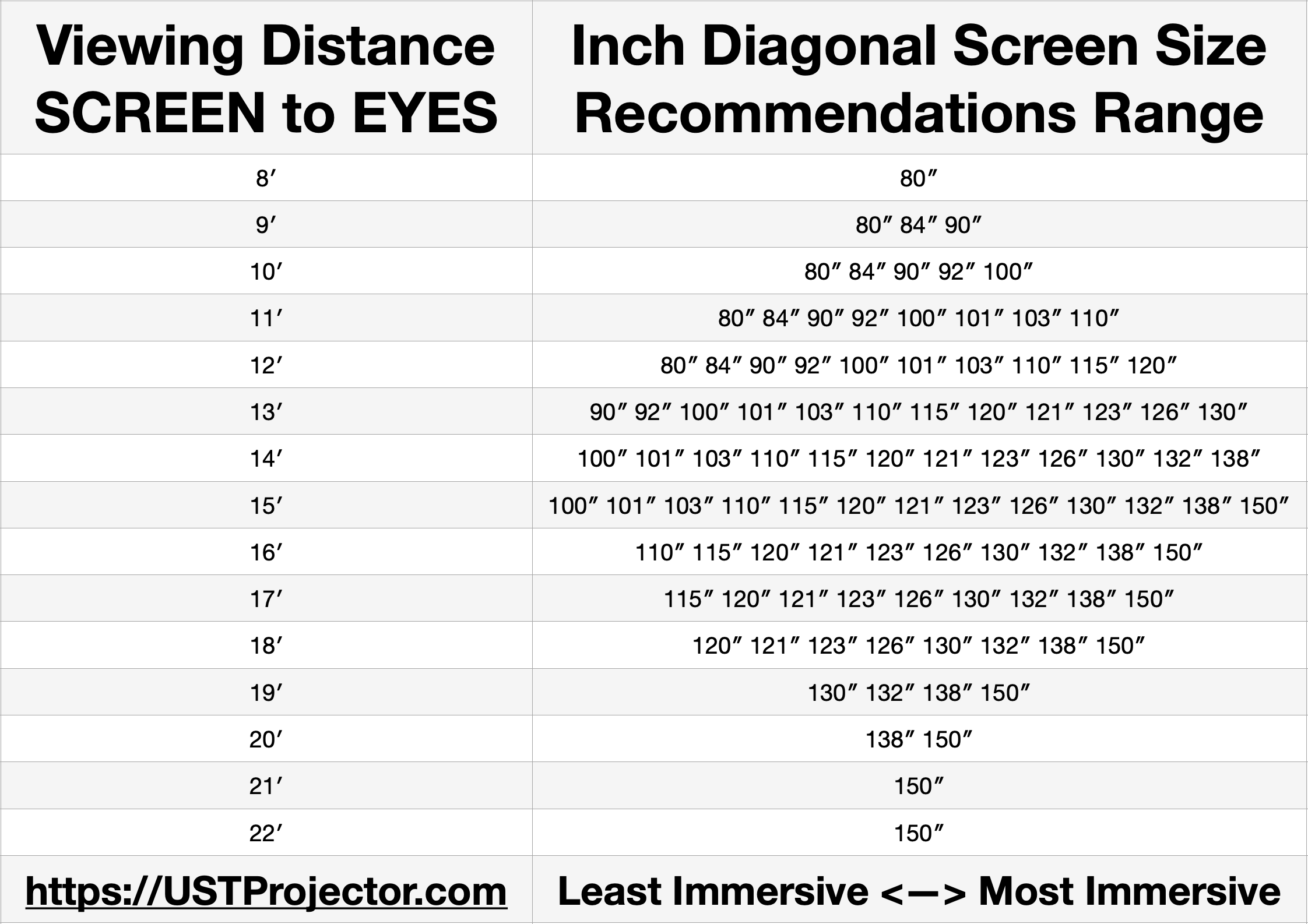The Best Ultra Short Throw Projectors Can Project
Up To 150″ Diagonal, Placed A Few Feet From Wall
UST stands for Ultra Short Throw. For quite some time now, ultra short throw video projectors with native 4:3, 16:10, and even 16:9 aspect ratios have been available for permanent installation in away-from-home corporate / boardroom and educational / classroom settings, typically installed with the UST projector being mounted “upside down” hanging from either the ceiling or the wall, just above a(n interactive) whiteboard or projection screen. These earliest types of UST projectors were NOT capable of 4K which is the current video standard for in-home usage.
Ever since the introduction of the “Laser TV” projector category over twelve years ago, ultra short throw projectors and UST ALR (Ambient Light Rejecting) projection screens intended for do-it-yourself in-home setup and installation, with the UST projector placed near a wall, sitting on or in a stand or cabinet or even directly on the floor, have become a feasible, desirable, popular, and ever more affordable SUPER-SIZED big screen television alternative. The best 4K ultra short throw projectors such as the highly-praised Hisense PX3-PRO pictured below are capable of projecting up to a 150″ diagonal image.
The Hisense 110 inch and TCL 115 inch mini-LED television are available from select retailers for about $15,000 or $20,000, respectively. (The luxury Samsung 114 inch MICRO LED is a mind-blowing $150,000!) The latest model of LG 97 inch diagonal 4K OLED TV is priced about $25,000. The prices on 100 inch and 98 inch diagonal LED televisions from Samsung, Sony, TCL, and Hisense currently range from as high as $15,000 to as low as $2,000 or even less for entry-level models.
As stated by a visitor to this site: “It’s not just the value, but it’s also the experience. I spoke to one of the top video calibrators in the country, himself being an owner of LG OLED like myself. These big TVs with their eye popping images are still just big TVs. There is something about a projector reflecting off a large screen that is more impactful. I think that despite the spectacular images of OLED TVs, they still do not recreate the theatrical experience the way a projector can.”
So, if you’ve got an average to larger-sized room in which you can be seated a proper distance away from a really big screen (see the large chart below) to watch movies, sports, shows, and/or play video games, you should definitely consider going with a 4K ultra short throw projector together with either a “Cinematic” lenticular or “Daylight” fresnel ALR projection screen.
The Viewing Distance and Screen Size Recommendations Chart below features just two columns. In the first column is the horizontal viewing distance measured between where your projection screen surface will be located, and where your eyes will be while comfortably seated, rounded to the nearest whole foot. In the second column are the corresponding ranges of recommended diagonal screen sizes in inches, from smallest and least immersive to largest and most immersive that work best for each viewing distance.

Based on the chart above, the AWOL Vision LTV-3500 Pro triple-laser 4K UST projector and lower-gain 132″ diagonal (11 foot) “Cinematic” lenticular wall-mount fixed-frame ALR projection screen pictured below left will work best together inside a semi-light-controlled room within an ideal viewing distance range of about 14 to 19 feet. see more UST projector and screen bundles
An “Ultra Short Throw” Projector is so-named because the distance it projects from the lens to the screen surface is extremely short. UST projectors are conveniently designed to be located vertically about a foot or a foot and a half or so underneath the bottom edge of a projection screen, placed horizontally just a few inches to a foot and half or so away from the wall, sitting atop a stand or inside a cabinet that extends a few feet out from the wall into your room, similar to a typical television stand. Alternatively, some ultra short throw projectors allow you to hang them from the ceiling using optional mounting hardware, flipped “upside down” installed together with a wall-mounted UST ALR screen in which the projection material has been rotated 180 degrees. A UST projector can produce a bright, colorful, high-contrast image even during daytime because it is located so near the screen, even in a living room, den, basement, or other environment with some ambient lighting issues. Of course, you will further improve the image contrast and detail if you can set it up in a darkened room such as a dedicated home theater.

Liberty Wide Pro 120″ diagonal UST ALR screen with hidden integrated three 3-way passive LCR (left, center, and
right) speakers from Bloomsbury Lab, Amazon.com UST projector and AV receiver sold separately YouTube video
Lastly, ultra short throw projectors do have built-in speakers similar to a small soundbar mounted inside the front of them, but you will definitely want to consider connecting your UST projector to a separate surround sound audio system using its HDMI eARC/ARC connection to create an immersive audiovisual experience at home that rivals going to your local movie theater.
Alternative domain names USTProjectors.com, UltraShortThrowProjector.com, and UltraShortThrow.com each forward to the homepage of this website when entered directly into the address bar of your web browser.
This page was last updated on May 25, 2025.




